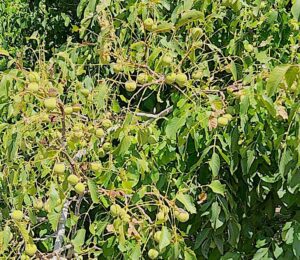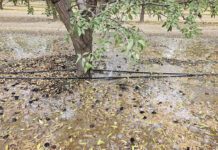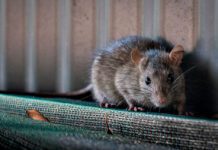
Almond, walnut and pistachio ranch manager DC Felciano watched as the infestation of grasshoppers consumed the leaves and hulls in one of his almond orchards west of Corning, Calif. and in the same area devoured the leaves in a walnut orchard in late June and early July.
The summer of 2024 has been the season of grasshoppers in the region of western Tehama County where the valley meets the foothills. Anywhere that a field of dry grass lies adjacent to an orchard, particularly young trees, the ravenous insects are causing havoc.
Tehama County isn’t the only area suffering infestation; reports have also come in from Placer County and other sites in Northern California’s Sacramento Valley. Grasshoppers have reached outbreak levels in other states as well, such as Montana, Nebraska and Colorado.
The problem isn’t anything new. In the 1930s, grasshoppers destroyed millions of acres throughout 17 western states, leading to a nationwide state of emergency. The National Guard was summoned, desperately addressing the problem with flame-throwers, dynamite and, eventually, arsenic.
Thankfully times have changed in the area of damage control, and a variety of insecticides are helping to curtail the problem.
Grasshopper Identification
According to the UC Davis Dept. of Entomology and Nematology, grasshoppers are robust, elongated insects with winged adults that are good flyers. Commonly they are brown, gray, green or yellowish insects with greatly enlarged hind-leg femurs adapted for jumping, and have relatively short antennae, which distinguishes them from crickets, katydids and other Orthoptera, which have long antennae.
They overwinter as eggs, hatching when the soil warms in spring. The nymphs feed on most any species of nearby green plants, molting five or six times before becoming adults.
Adults live and feed for two to three months, during which females typically lay pods of 20 to 100 eggs in the topsoil of undisturbed areas.
Grasshoppers are movers, feeding voraciously and migrating to “greener pastures,” so to speak, sometimes in large swarms with the adults flying and nymphs jumping.
In addition to consuming almost anything green in its path, the insect can be carnivorous, with adults feeding on young nymphs.
As Felciano was walking down Black Butte Road west of Corning, grasshoppers were jumping all around him.
“They are everywhere out here among the dry grass where they hatched this wet, warm spring,” he said.
Sporadic Damage
Driving down roads in western Tehama County the damage caused by the grasshoppers is hit-and-miss, no apparent method to the madness.
“I have seen areas where entire young orchards are hit, not hardly a leaf left on the trees,” Felciano said. “What I have found in my orchards is trees hit pretty bad that are next to roads that are next to fields of dry grass. The grasshoppers have crossed the roads into the orchards and attacked the outer perimeter trees. You go three or four rows in and the damage is less and less. The further in you go in, there isn’t any damage at all.”
He noted the worst damage is among the young trees.
UC Davis researchers report grasshoppers become economic pests mostly among young trees, as Felciano has witnessed, where the insects devour the leaves.
Felciano has also seen firsthand the swarms eating the green hulls off this year’s almond crop.
“Even with the damage I’m seeing, we are going to have a good crop as the damage has been somewhat limited to the outer trees and young trees that didn’t have much of a crop anyway,” he added.
Among Felciano’s walnut orchards, he has seen the same damage. The grasshoppers have attacked the outer perimeter trees, but less and less within the depths of the orchard.
They haven’t gone after the fruit, but the damage comes from sun damage to the now unprotected fruit, resulting in sunburn,” Felciano said.
In the bigger picture, the damage caused by the grasshopper invasion goes into next year, both in financial costs and stress to the trees.
Felciano explained, “Everywhere that the grasshoppers have eaten the trees’ leaves, the trees are pushing out new leaves. That is a lot of stress on these trees, especially during this hot, hot summer, and as they are also ripening their fruit.”
He is already planning for the need of additional fertilizer application to the damaged trees to compensate for the added stress and energy the trees are using to combat the insect damage.
The damage is also seen in the pocketbook. Felciano talked about the cost of additional pesticide applications and fertilizers.
“It’s in the hundreds of thousands,” he said. “It is a really good thing almond prices are up a bit this year to help compensate.”

Control Measures
As soon as Felciano was aware of the infestation, he went into damage control mode.
“I immediately called my pest management company that uses a helicopter and started applying pesticides from the air,” he said. “We have also applied from the ground and placed Sevin around the perimeters of the orchards. And we haven’t done this just once, with grasshoppers the applications have had to be several and aggressive.”
Grasshoppers can be difficult to manage once large numbers move onto orchards, especially young trees, according to UC Davis.
“If you believe grasshoppers may become a problem, monitor for them in uncultivated areas near young trees. Before adjacent vegetation dries or is cut, consider applying insecticide combined with bait or spraying border areas to kill grasshoppers before they migrate and start to damage crops,” researchers advised.
UC IPM said growers can apply a bait containing carbaryl around the borders of their orchards before grasshoppers arrive.
These insecticides have only a few days of residual activity against grasshoppers, and because baits lose their effectiveness after rain or irrigation, they will need to be reapplied if migrations continue.
Pesticides containing the active ingredient carbaryl are restricted use materials in California. A valid pesticide applicator’s license is required for their possession and use.
“Carbaryl and other insecticides such as cyfluthrin or other pyrethroids commonly used as sprays for grasshopper control are very toxic to bees, natural enemies of grasshoppers, and aquatic life, although carbaryl in bait form is less hazardous to bees. Reserve the use of insecticides for serious situations where they may provide a significant level of control, ideally as baits around the edge of the garden before grasshoppers invade,” UC IPM reported.
Help
During a Tehama County Board of Supervisors meeting in June, Agriculture Commissioner Thomas Moss said the department has been receiving reports of destruction caused by the grasshopper infestation but has yet to determine the overall outcome. The damage won’t be known until the infestation has abated, and when that will be is yet to be seen.
Moss said the Tehama County Dept. of Agriculture is sending out a survey to growers and residents to establish an understanding of the problem.
In addition to the surveys, inspectors from the county and state will be onsite to assess the damage.
With the outcome of the infestation still uncertain, Moss said disaster declarations must happen within 60 days of the incident, so his department is quickly trying to keep abreast on the situation daily and relay information to the Farm Bureau.















